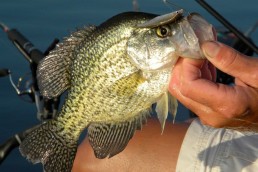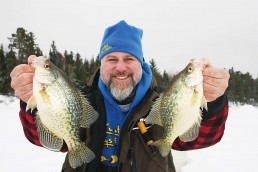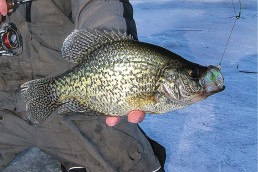Crappies on Ice
SHARE THIS POST
There is something special about plucking fish through the ice that gives us “Ice Fever.” Ice fever is defined as “rapid heartbeat due to intense excitement when catching fish through the ice.” And there’s no better fish to catch through the ice than feisty crappies.
When the ice gets hard, there are hordes of anglers who congregate on key lakes throughout the Midwest and many of them are targeting crappie.
There are several reasons for chasing these specks. One is that when you find one, you’ll often find several. Second, they are tremendous fighters, especially when you are using light line and a limber ice rod like St. Croix’s new Avid Glass Ice rods. Third, they taste great on cold winter evenings after a long day on the ice.
One of our favorite lakes that has been hot over the past few years is Lake Thompson, located in eastern South Dakota. Lake Thompson is the second largest natural lake in South Dakota and is over 18,000 acres in size. This lake was formed during the glacial period of our earth’s history and has a maximum depth of approximately 20 feet. Large numbers of walleye, northern pike, yellow perch and crappies inhabit this lake with many different locations to find them
The fishing on Lake Thompson has been excellent over the years, as its diverse habitat has been proven to sustain a tremendous population of fish. The tranquil backwater areas are perfect for crappie spawning habitat and that is exactly where you’ll find them during first ice. The result—crappies are stacked in specific, shallow areas that contain brush and logs.
The great part of fishing on Lake Thompson is if you find one, you find a bunch. The downside is that anglers have to be careful about not to take so many that they harm the population.
There have been times where a limit of 15 can be caught in less than 15 minutes. Two rods are legal in South Dakota, but one is about all a guy can handle when the action is fast and furious. When it’s like this, we suggest releasing the large 14 inchers and keeping a few 10 to 12 inchers for cleaning.
Speaking of cleaning, there’s new tool available that makes cleaning easy, fast and with very little waste. When you have numbers of fish, the Skinzit is a “must have.” Skinzit is an electric fish skinner that quickly takes the ribs and the skin off in seconds. You are left with a perfect fillet every time with no bones and little wasted meat!
Good ice fishing strategies begin by finding the areas where crappie will spawn during the spring. Subtle holes and channel areas located near brush and timber hold the fish. Find some wood and you’ll find the crappies. This cover concentrates the fish.
This next summer, try finding these spots during open water, since it is far easier to slowly motor on a boat than drilling tons of holes through thick Thompson ice.
Use your GPS to pinpoint several likely locations and use your side imaging to find the brush piles and to learn each area’s subtle characteristics that will be the spot-on-the-spot.
Once the water freezes up, take some friends and punch a few holes in the area. Use your electronics, such as Humminbird’s Ice Helix 5, to look for marks that signal fish. If they’re there, they will show up immediately.
Are you enjoying this post?
You can be among the first to get the latest info on where to go, what to use and how to use it!
Most are suspended near cover in about 5 to 8 feet of water. Watch your screen and adjust the depth of your jig as fish appear in the cone.
Some crappies will also hold on the deeper cover just outside the bays near deeper channel bends.
Although small crappie minnows and wax worms are deadly most of the time, try some small plastic tails on your jigs. Some of these new soft ice plastics are tremendous and you don’t have to always be digging into a cold minnow bucket.
Crappies are curious and after you catch one or two, others will come in to see what their buddies are feeding on. Always keep bait in front of them in order to maintain the feeding frenzy.
Crappies also seem more color-sensitive than many other species, so make changes often to see what they want on any given day. Also change up your jigging motion several times on the quarter hour. An aggressive motion will often attract the fish and as they appear on your electronics, see if they will bite. If not, then slow the motion down and quiver the jig. Then pause and stop it completely.
Another tip to try is to drop the jig all the way down into the muddy/sandy bottom, then raise it up quickly and keep it still. The poof of the silt seems to attract attention and the crappies will come up and will often blast the jig.
If the action is just plain slow, then actively jig with your first rod and use your second rod as a “dead” rod. Rig it up with one of Venom’s new ice floats. These floats are tremendous since you can adjust the float without any cutting or re-tying. If you switch to a heavier jig or spoon, then you just slide the foam up or down to maintain maximum sensitivity.
If there’s no luck quickly, then move to another spot. Crappies are not shy and it won’t take long to know if the spot is productive.
Crappie fever is contagious, so be careful when talking to other anglers about catching ‘em. You’ll have a bunch of company the next time you go out for sure. And practice selective harvest. We want the fish to be there next winter.
MWO
SHARE THIS POST
Did you enjoy this post?
You can be among the first to get the latest info on where to go, what to use and how to use it!
Ted Takasaki
Ted Takasaki is an International Fishing Hall of Fame professional angler who has been featured in many national outdoor magazines and television shows. Takasaki has appeared in front of thousands of angling enthusiasts and is considered one of America’s top walleye and multispecies anglers. Follow him on his Facebook page.



